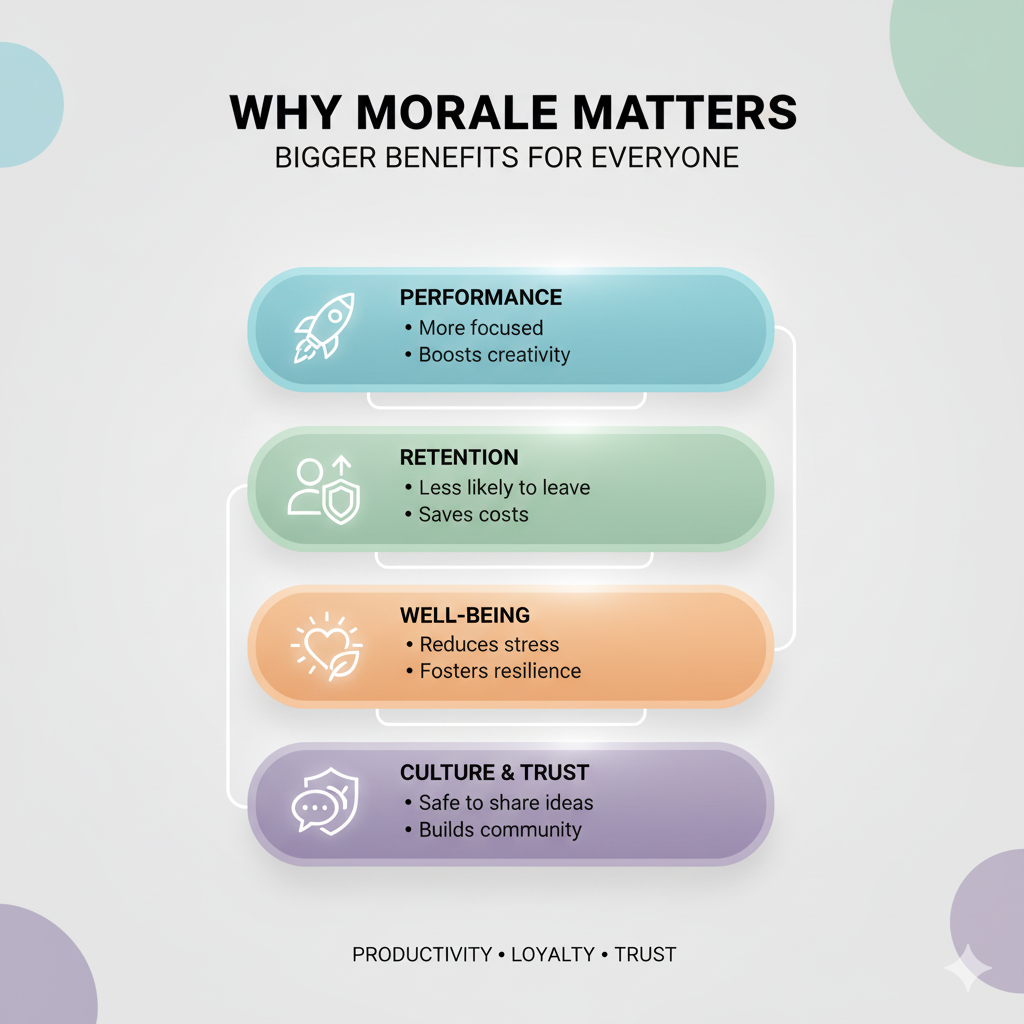Imagine walking into an office where the energy feels heavy. Conversations are short, smiles are rare, and employees move through their tasks with little excitement. This is often a sign of low workplace morale, and it affects both people and performance.
Workplace morale refers to the overall emotional climate within a team or organization. When morale is high, employees feel motivated, engaged, and connected. When morale is low, it can result in stress, absenteeism, and declining productivity.
This article will explore what morale means, why it matters, and practical ways to improve it. You will learn about proven employee morale strategies, examples of morale boosters, common pitfalls, and ways to measure progress. By the end, you will also see how Yuna can help organizations boost morale in the workplace.
What Does Morale in the Workplace Mean?
Before diving into strategies, it is important to understand what morale actually means. Morale is more than temporary happiness. It reflects the lasting attitude and emotional state of employees toward their work and workplace.
Emotional and Attitudinal Foundations
Workplace morale is the emotional climate that shapes how employees feel day to day. When morale is positive, people show enthusiasm, trust, and a willingness to contribute to shared goals. They feel motivated to go beyond the basics of their role.
On the other hand, negative morale often leads to apathy, resentment, or withdrawal. Employees may still complete tasks, but they do so without energy or passion. Over time, this drains the spirit of the team. Morale shapes not only individual behavior but also the collective tone of the workplace.
Morale vs Engagement vs Satisfaction
It is common to confuse morale with related terms like engagement and satisfaction. While they overlap, each has its own meaning. Satisfaction refers to general contentment with work conditions such as pay or hours. Engagement reflects the level of active involvement and focus an employee brings to their role.
Morale is slightly different. It reflects the emotional readiness and spirit that employees carry into work. It is the foundation that influences both satisfaction and engagement. Without good morale, other positive efforts may not reach their full impact.
Consequences of Low Morale
When morale in the workplace drops, the effects can be serious. Low morale often leads to reduced productivity, frequent absenteeism, and higher turnover rates. It can cause stress to spill over across teams, creating tension and misunderstandings.
There is also a direct connection between poor morale and mental health concerns. Employees experiencing prolonged low morale are more likely to feel burned out or disconnected. This makes improving morale at work not only a business priority but also a human responsibility.

Why Boosting Employee Morale Matters
Organizations cannot afford to ignore morale. Boosting morale brings tangible benefits for employees, teams, and overall business outcomes.
Performance and Productivity Gains
Research consistently shows that morale is linked to performance. Employees with higher morale are more focused, efficient, and creative. They are more likely to offer solutions and take ownership of their work. Teams with strong morale often outperform competitors because they bring energy and innovation to tasks.
Retention and Reduced Turnover
High morale also helps organizations retain talent. Employees are less likely to leave when they feel supported and valued. A positive culture reduces the hidden costs of rehiring and retraining. Retaining skilled staff is one of the strongest long-term results of strong employee morale strategies.
Better Mental Health and Well-being
Boosting morale also improves employee well-being. A workplace that fosters morale reduces stress and anxiety levels. Employees feel more resilient when they face challenges. Emotional support through morale contributes to both job satisfaction and personal happiness.
Stronger Culture and Trust
Finally, morale strengthens culture and trust. When morale is high, employees feel safe sharing ideas or concerns. They experience psychological safety, which encourages openness and teamwork. A workplace built on morale becomes a community where people thrive together.
Boost employee morale consistently, and the rewards show up in trust, productivity, and loyalty.
Key Strategies to Boost Morale
Improving morale requires consistent actions, not one-time fixes. The following strategies show how to boost morale in the workplace and create lasting improvement.
Recognition and Appreciation
Timely recognition is one of the simplest morale boosters. Employees want their efforts to be seen and appreciated. Recognition can be public, such as in team meetings, or private through a personal note. Both forms show that contributions matter. Without appreciation, morale can slip even when pay and benefits are fair.
Transparent Communication and Leadership
Communication builds trust. When leaders share information openly, employees feel included in decisions. A transparent approach prevents rumors and shows respect. Employees are more likely to trust leadership when they know what is happening and why. Clear and open leadership improves morale at work more than any perk.
Flexibility and Work-Life Balance
Work-life balance is a central part of morale. Offering flexible hours or remote work options reduces stress. Flexibility shows that the organization values employees as people with lives outside of work. It also helps prevent burnout, a major cause of low morale.
Growth and Development Opportunities
Employees want to grow in their careers. Offering training, mentorship, or new projects communicates investment in their future. Growth opportunities keep morale high because they show that employees are not stuck. Development is one of the most reliable employee morale strategies.
Team Building and Social Rituals
Morale also grows through connection. Informal check-ins, shared meals, or events create bonds beyond work tasks. Rituals like celebrating birthdays or team wins add meaning. These activities may seem small, but they build a sense of belonging that sustains morale.
Regular Feedback and Employee Voice
Employees need to feel heard. Two-way communication through regular feedback sessions gives employees a voice. Listening and responding to concerns shows respect. It prevents small issues from growing into larger morale problems. Consistent listening is a clear answer for improving morale at work.

Examples of Morale Boosting in Action
Understanding strategies is one thing, but seeing them in practice shows their true value. These examples highlight how organizations put morale into action.
Remote Recognition via Slack
Many companies now use tools like Slack to give quick recognition. Virtual shout-outs in dedicated channels allow peers and managers to celebrate contributions instantly. This builds morale in distributed teams and keeps everyone connected despite distance.
Meeting-Free Days and Autonomy
Some organizations protect morale by scheduling meeting-free days. These days give employees space for focus and autonomy. The result is greater trust and respect, as workers feel their time is valued. Autonomy encourages motivation and reduces stress.
Crowdsourcing Team Activities
Instead of leaders deciding all team activities, some companies let employees choose. By crowdsourcing events like games, wellness sessions, or social outings, employees take ownership. This creates stronger engagement and boosts morale through shared decision-making.
Green Spaces and Workspace Design
Simple workspace improvements can raise morale. Natural light, green plants, and comfortable seating reduce stress. Break areas encourage social interaction. Even small design changes remind employees that their comfort matters, improving workplace morale.
Challenges and Common Pitfalls
Building morale is not always straightforward. Organizations often make mistakes that reduce the effectiveness of their efforts.
Inconsistent Leadership Behavior
Employees quickly lose trust when leaders say one thing but act differently. For morale to stay high, leadership behavior must align with stated values. Inconsistency creates doubt and breaks trust faster than any other issue.
Token Gestures (Superficial Rewards)
Another pitfall is relying on superficial perks. Small rewards or treats without deeper changes come across as token gestures. True morale improvement requires listening, respect, and support, not just perks.
Overlooking Individual Differences
Finally, not all employees respond to morale boosters in the same way. What motivates one person may not inspire another. Overlooking these differences can weaken results. A flexible approach works best to respect diverse needs.
Workplace morale must be treated with authenticity and care, supported by genuine employee morale strategies.
Measuring and Sustaining Morale
Morale cannot be improved once and forgotten. It needs to be measured and sustained over time to remain strong.
Pulse Surveys and Check-ins
One method is to use quick, anonymous pulse surveys. These short check-ins give leaders a regular view of how employees feel. Regular feedback prevents issues from going unnoticed.
Morale Metrics and KPIs
Tracking absenteeism, retention, and engagement scores also provides useful insight. These measurable signs reflect the health of morale. Leaders can combine survey results with metrics for a fuller picture.
Adjustment and Continuous Improvement
Finally, morale strategies must be adjusted as the workplace changes. Continuous improvement shows employees that leadership cares and listens. Morale improvement is an ongoing process, not a one-time project.
This focus on team morale improvement helps create a culture of trust and progress.

Let Yuna Help You Boost Workplace Morale
Boosting morale takes the right tools and consistency. Yuna supports organizations with solutions that make morale a daily priority.
Yuna offers reminders, engagement tracking, and tools for leaders to strengthen connections with their teams. Employees benefit from a system that helps them feel recognized and supported. Managers gain insights into morale trends and ways to act before problems grow.
By using Yuna, organizations can boost morale in the workplace more effectively. It gives both leaders and employees the resources they need to improve morale at work and sustain it long term.
Partner with Yuna to put employee morale strategies into action. Together, you can create a workplace where energy, trust, and motivation thrive.
FAQs
What is workplace morale?
Workplace morale is the overall emotional and mental state of employees in their work environment. It reflects how motivated, positive, and engaged they feel toward their tasks and the organization.
Why does employee morale drop?
Employee morale often drops due to high workloads, lack of recognition, unclear communication, or poor leadership. When employees feel undervalued or unsupported, morale declines quickly.
What are simple ways to boost morale quickly?
Quick ways to boost morale include giving timely recognition, offering short breaks, or holding informal listening sessions. These actions show care and can lift morale immediately.
How long does it take to improve morale?
Some changes, like recognition, show results quickly. Deeper improvements, such as building trust or creating flexible policies, may take weeks or months. Sustained action creates lasting morale.
What role do leaders play in morale?
Leaders play a central role in morale. They set the tone, model behavior, and create policies that shape the emotional climate. Leadership consistency is key to strong morale.


.webp)



